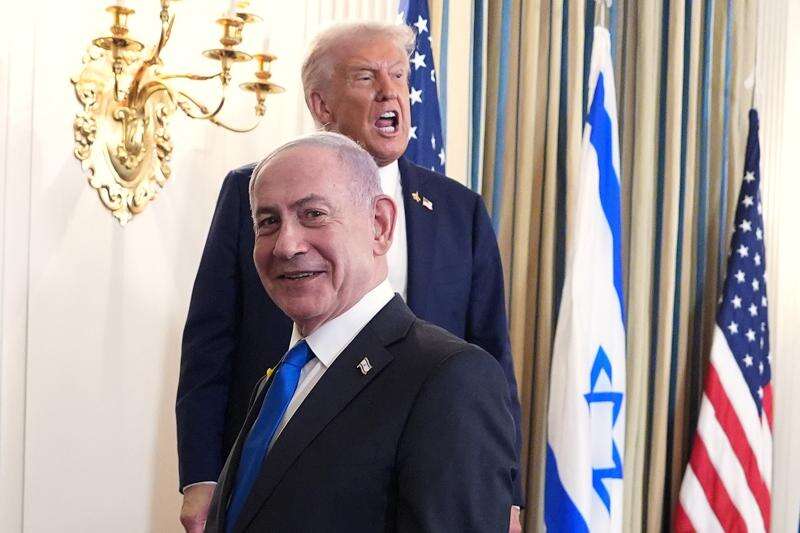Top Stories
Trump’s Bold Maneuver Paves Way for Gaza Ceasefire Agreement

In a surprising turn of events, a ceasefire agreement between Israel and Hamas was reached, marking a significant breakthrough in the ongoing conflict in Gaza. This development follows President Donald Trump‘s decisive intervention, which altered the dynamics of negotiations that had previously stalled for months. Under the terms of the agreement announced Wednesday, the last 48 hostages, including 20 believed to be alive, are expected to be released.
The negotiations have been fraught with challenges since the October 7, 2023 attack by Hamas on Israel, which triggered a devastating war. Major concerns remain regarding the governance and reconstruction of Gaza, a territory largely devastated by conflict, as well as whether Hamas will agree to disarm—an essential demand from Israel still unaccepted by the militant group.
Ceasefire Negotiations Reach a Critical Juncture
As recently as September, discussions mediated by the U.S., Egypt, and Qatar had reached a standstill. Trump’s Middle East envoy had walked away from the talks, attributing the breakdown to Hamas’ inflexible stance. In a surprising development, Hamas later accepted a proposal that mediators indicated was nearly identical to one previously approved by Israel, yet there was no official response from Israel or the U.S. at that time.
Hamas maintained its position, insisting that the release of hostages would require the release of hundreds of Palestinian prisoners, a full ceasefire, and a complete withdrawal of Israeli forces from Gaza. Israeli Prime Minister Benjamin Netanyahu firmly rejected these terms, stating that hostilities would only cease with Hamas’ surrender and the return of all captives, while maintaining ongoing security control over Gaza.
On September 9, tensions escalated dramatically when an Israeli airstrike targeted Hamas leaders in Doha, Qatar, resulting in the deaths of five Hamas members and a Qatari security personnel. This strike provoked outrage among Gulf Arab leaders and angered the White House, prompting Trump to engage in damage control efforts to reassure Qatar. The incident raised alarms among U.S. allies in the region, including Turkey and Egypt, who have historically hosted Hamas leaders.
Shifting Dynamics and the Path to Peace
The airstrike united members of the Gulf Cooperation Council (GCC) in a manner not seen since its formation in 1981, prompting a reevaluation of their positions on Israel. Conversations among GCC states indicated a growing perception that Israel posed a greater threat to regional stability than Iran. Such developments could have far-reaching consequences for the Trump administration’s strategy to counter Iran, especially given its reliance on military bases in Bahrain and Qatar.
Two weeks after the airstrike, Trump convened a meeting with leaders from eight Arab and Muslim nations during the United Nations General Assembly, emphasizing the need to address Israel’s increasing isolation. Secretary of State Marco Rubio noted that the meeting catalyzed efforts to build a coalition supporting Trump’s peace plan.
Trump subsequently unveiled a comprehensive 20-point peace plan, coinciding with Netanyahu’s fourth visit to the White House in 2023. In an effort to mend relations with Qatar, Trump engaged in direct communication with Qatari Prime Minister Mohammed bin Abdulrahman Al Thani before presenting Netanyahu with a drafted apology for the airstrike.
Following this, Netanyahu announced his acceptance of Trump’s plan during a press conference, while Trump’s negotiators intensified their efforts to secure Hamas’ agreement through intermediaries in Qatar and Egypt. The U.S. proposal required Hamas to release remaining hostages within 72 hours of a ceasefire, relinquish control of Gaza, and disarm—essentially demanding the group’s surrender.
Trump issued a stark warning via social media, stating, “If this LAST CHANCE agreement is not reached, all HELL, like no one has ever seen before, will break out against Hamas.” Hours later, Hamas responded, reiterating its willingness to release all hostages in exchange for Palestinian prisoners but leaving other aspects of the proposal open for further negotiations.
Despite Hamas’ conditional acceptance, U.S. and Israeli officials, faced with a potential stalemate, opted to interpret the response as a favorable sign. Trump was the first to publicly respond, declaring on his social media platform that Hamas was ready for a lasting peace and urging Israel to halt its bombings in Gaza to facilitate the safe retrieval of hostages.
In a subsequent statement, Netanyahu confirmed Israel’s preparedness to implement the initial phase of Trump’s plan, focusing on the hostages’ release while remaining committed to its objectives in the conflict. Israeli Foreign Minister Gideon Saar expressed skepticism regarding Hamas’ acceptance but acknowledged Trump’s strategic framing of the situation as a momentum shift. This approach, he noted, ultimately proved to be “brilliant.”
As the ceasefire talks progress, the international community is watching closely, hopeful for a resolution that could alleviate the widespread suffering in Gaza and stabilize the region. The implications of this agreement extend beyond immediate humanitarian concerns, potentially reshaping the geopolitical landscape of the Middle East.
-

 Lifestyle3 months ago
Lifestyle3 months agoLibraries Challenge Rising E-Book Costs Amid Growing Demand
-

 Sports3 months ago
Sports3 months agoTyreek Hill Responds to Tua Tagovailoa’s Comments on Team Dynamics
-

 Sports3 months ago
Sports3 months agoLiverpool Secures Agreement to Sign Young Striker Will Wright
-

 Lifestyle3 months ago
Lifestyle3 months agoSave Your Split Tomatoes: Expert Tips for Gardeners
-

 Lifestyle3 months ago
Lifestyle3 months agoPrincess Beatrice’s Daughter Athena Joins Siblings at London Parade
-

 World3 months ago
World3 months agoWinter Storms Lash New South Wales with Snow, Flood Risks
-

 Science3 months ago
Science3 months agoTrump Administration Moves to Repeal Key Climate Regulation
-

 Science2 months ago
Science2 months agoSan Francisco Hosts Unique Contest to Identify “Performative Males”
-

 Business3 months ago
Business3 months agoSoFi Technologies Shares Slip 2% Following Insider Stock Sale
-

 Science3 months ago
Science3 months agoNew Tool Reveals Link Between Horse Coat Condition and Parasites
-

 Sports3 months ago
Sports3 months agoElon Musk Sculpture Travels From Utah to Yosemite National Park
-

 Science3 months ago
Science3 months agoNew Study Confirms Humans Transported Stonehenge Bluestones









